
3D rendering of a fruit fly brain generated through x-ray holographic nano-tomography (XNH). The tissue outline is shown in blue, while neurons are highlighted in orange. Image: Kuan et al, 2020.
One of the grand quests in neuroscience is to build a precise map of the brain, charting all its neurons and the connections between them. Such a wiring diagram, called a connectome, promises to help shed light on how a collection of cells can together give rise to thoughts, memories, behaviors and myriad other functions.
Now, researchers at Harvard Medical School, Boston Children’s Hospital and the European Synchrotron Radiation Facility (ESRF) have demonstrated that a new x-ray microscopy technique could help accelerate efforts to map neural circuits and ultimately the brain itself.
Reporting in Nature Neuroscience on Sept. 14, the team describes how x-ray holographic nano-tomography (XNH) can be used to image relatively large volumes of mouse brain and fruit fly nervous tissue at high resolutions.
Combined with artificial intelligence-driven image analysis, they reconstructed dense neural circuits in 3D, comprehensively cataloging neurons and even tracing individual neurons from muscles to the central nervous system in fruit flies.
“We think this is going to open new avenues for understanding the brain, both in how it’s organized and the circuitry that underlies its function,” said co-corresponding author Wei-Chung Allen Lee, HMS assistant professor of neurology at Boston Children’s. “This type of knowledge can give us foundational insights into neurological disorders, diseases that affect the structure of the brain and much more.”
For biological questions like neural circuit discovery, x-ray microscopy holds several advantages over current approaches based on electron microscopy (EM), according to the authors.
“We think XNH can bring a lot of value to neuroscience, because we can now access much larger volumes in shorter times,” said co-corresponding author Alexandra Pacureanu, a scientist at the ESRF. “This is the beginning of a new approach for efforts to map neural circuits.”
Near-light speed
Studying the connectome is a monumental challenge. The human brain, for example, contains some 100 billion neurons with 100 trillion neural connections, roughly the number of stars within 1,000 galaxies.
In animal models, scientists have made remarkable progress, such as imaging an entire fruit fly brain, primarily by taking serial slices of a brain, each a thousand times thinner than a human hair, imaging the slices with EM and stitching the images together for analysis.
“The hope is we could someday help address questions like: can we understand neural circuits that underlie complex behaviors like decision making? Can we reverse engineer the algorithms of the brain?”
Wei-Chung Allen Lee
An XNH scan of an adult fruit fly brain. Video: Kuan et al, 2020
XNH reconstruction of the motor and sensory neurons in a fruit fly leg. Video: Kuan et al, 2020





